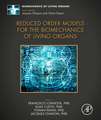Biomechanics of the Aorta: Modeling for Patient Care: Biomechanics of Living Organs
Editat de T. Christian Gasser, Stéphane Avril, John A. Elefteriadesen Limba Engleză Hardback – 20 iun 2024
Divided into five parts, the book begins with an introduction to the fundamental aspects of the anatomy, biology, and physiopathology of the aorta, and then proceeds to present concepts of imaging and tissue/rheology characterization, tissue modeling and rupture, and flow modeling and algorithms. The final part dives into applications and case studies including transcatheter aortic valve implantation, aortic aneurysm rupture prediction, aortic dissections, and pharmacological treatments.
- Comprehensive coverage of the main computational fluid dynamic studies and biomechanical and mechanobiological models developed over the last decade
- Introduces the most recent imaging technologies to characterize factors, including aortic geometry, mechanical properties of aortic tissues, and cellular activity in the vessel wall
- Synthesizes advances in vascular biomechanics, medical imaging, and computational modeling of finite element fluid and solid models
Preț: 971.45 lei
Preț vechi: 1067.52 lei
-9% Nou
Puncte Express: 1457
Preț estimativ în valută:
185.89€ • 198.78$ • 154.99£
185.89€ • 198.78$ • 154.99£
Carte tipărită la comandă
Livrare economică 11-25 aprilie
Preluare comenzi: 021 569.72.76
Specificații
ISBN-13: 9780323954846
ISBN-10: 0323954847
Pagini: 634
Dimensiuni: 191 x 235 mm
Greutate: 1.29 kg
Editura: ELSEVIER SCIENCE
Seria Biomechanics of Living Organs
ISBN-10: 0323954847
Pagini: 634
Dimensiuni: 191 x 235 mm
Greutate: 1.29 kg
Editura: ELSEVIER SCIENCE
Seria Biomechanics of Living Organs
Public țintă
Graduate students, post-docs, and professionals in biomedical and biomechanical engineering; as well as biomedical and clinical researchers; all who need to: -understand fundamental properties of the aorta, -conduct experimental procedures, -perform animal experiments, -design and test clinical devices, and -develop biomechanical finite element computations of the aortaCuprins
PART 1 Anatomy, biology, physiopathology
1. Physiopathology
2. Genetics of aortic disease
3. Mechanobiology of aortic cells and extracellular matrix
4. Clinical treatment options
PART 2 Imaging and tissue/rheology characterization
5. Novel experimental methods to characterize the mechanical properties of the aorta
6. Imaging aortic flows in 4D using MRI
7. Ultrasound imaging for aortic biomechanics
8. Functional imaging, focus on [18F]FDG positron emission tomography
9. Image processing: Deep learning for aorta model reconstruction
PART 3 Tissue modeling and rupture
10. On simulation of the biophysical behavior of the aortic heart valve interstitial cell
11. Abdominal Aortic Aneurysm and thrombus modeling
12. Computational modeling of aneurysm growth in mechanobiology
13. Analysis of aortic rupture: A computational biomechanics perspective
14. Multiscale modeling of aortic mechanics: Tissue, network, and protein
PART 4 Flow modeling and algorithm
15. Multiphysics flow modeling in the aorta
16. Novel Approaches for the numerical solution of fluid-structure interaction in the Aorta
17. Turbulence modeling of blood flow
18. Inverse problems in aortic flow modeling
19. Modeling of flow induced mechanosignaling
20. Reduced order modeling of cardiovascular hemodynamics
PART 5 Applications
21. Transcatheter aortic valve implantation (TAVI)
22. Abdominal Aortic Aneurysm rupture prediction
23. (T)EVAR simulation
24. Fluid Structure Interaction (FSI) in aortic dissections
25. Pharmacological treatments, mouse models, and the aorta
1. Physiopathology
2. Genetics of aortic disease
3. Mechanobiology of aortic cells and extracellular matrix
4. Clinical treatment options
PART 2 Imaging and tissue/rheology characterization
5. Novel experimental methods to characterize the mechanical properties of the aorta
6. Imaging aortic flows in 4D using MRI
7. Ultrasound imaging for aortic biomechanics
8. Functional imaging, focus on [18F]FDG positron emission tomography
9. Image processing: Deep learning for aorta model reconstruction
PART 3 Tissue modeling and rupture
10. On simulation of the biophysical behavior of the aortic heart valve interstitial cell
11. Abdominal Aortic Aneurysm and thrombus modeling
12. Computational modeling of aneurysm growth in mechanobiology
13. Analysis of aortic rupture: A computational biomechanics perspective
14. Multiscale modeling of aortic mechanics: Tissue, network, and protein
PART 4 Flow modeling and algorithm
15. Multiphysics flow modeling in the aorta
16. Novel Approaches for the numerical solution of fluid-structure interaction in the Aorta
17. Turbulence modeling of blood flow
18. Inverse problems in aortic flow modeling
19. Modeling of flow induced mechanosignaling
20. Reduced order modeling of cardiovascular hemodynamics
PART 5 Applications
21. Transcatheter aortic valve implantation (TAVI)
22. Abdominal Aortic Aneurysm rupture prediction
23. (T)EVAR simulation
24. Fluid Structure Interaction (FSI) in aortic dissections
25. Pharmacological treatments, mouse models, and the aorta



